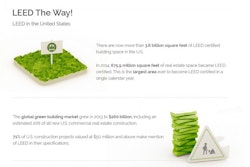
A new study conducted by Dodge Data & Analytics in collaboration with Siemens, titled “Corporate Sustainability Reaches Middle Age: A Review of Key Trends and Insights from 9 Years of Research,” finds top U.S. companies' involvement in sustainability continues to grow, with many reporting strong business benefits. But the study also reveals a gap between the majority of committed companies and a minority of companies that do not see the business value of investing in sustainability.
Since its inception, the study, which was first conducted in 2006, 2009, 2012 and now in 2015, has created a five-stage sustainability scale ranging from those companies that do not include sustainability as part of their mission to those who view sustainability as a transformative driver for their business. The findings demonstrate that the percentage of companies at the high end of the scale has grown from 15% in 2006 to 41% in 2015. However, there has also been a slight increase in those at the lower end of the scale as well, with 21% in 2015 compared to 17% in 2012.
Stages of Corporate Sustainability
- Sustainability is not part of the company mission. The company views sustainability as complying with government regulations.
- Company has started to engage in sustainability, but sustainability is viewed as a cost.
- Company considers the proactive application of sustainability to be consistent with the profit mission. However, it has not built sustainability into its technologies, policies, and operations on an institution-wide basis.
- Company is a green organization. Sustainability is viewed more as an opportunity than a cost and integrates sustainability with key strategies.
- Company views sustainability as a transformational driver and is driven by a passionate, values-based commitment to improving the well-being of the company, society, and the environment. The company approaches business as a holistic, restorative company.
This “green gap” corresponds closely to the respondents’ perceptions of the benefits of investing in sustainability. Eighty percent or more of those at the high end of the scale believe that their sustainability gives them a stronger competitive advantage and helps them retain or attract employees and customers, but 60% or fewer of those at the low end believe the same. In addition, 60% percent of the companies at the high end of the scale believe their green buildings have higher asset values, compared with just 30% percent of those at the low end; there is also a striking gap between their expectations that they get higher corporate valuation from green investments (58% percent versus 39% percent) and increased company financial performance (61% percent versus 29% percent).
“Those companies that invest in sustainability see clear value coming from those investments,” says Stephen A. Jones, Senior Director of Industry Insights at Dodge Data & Analytics. “Companies that ignore these benefits may eventually find themselves at a competitive disadvantage.”
One key difference between companies at the high and low ends of the scale is having a person or team dedicated to sustainability. The findings suggest that committing those resources is a critical step, especially when comparing the responses of those in the C-suite between companies that have those resources and ones that don’t. Those in the C-suite are seeing much higher levels of activity and value from their sustainability commitments when they have those resources, compared with those that don’t. “The data suggests that having a person or team dedicated to sustainability is the most influential factor for a company to fully achieve the benefits from their sustainability efforts,” says Jones.


















